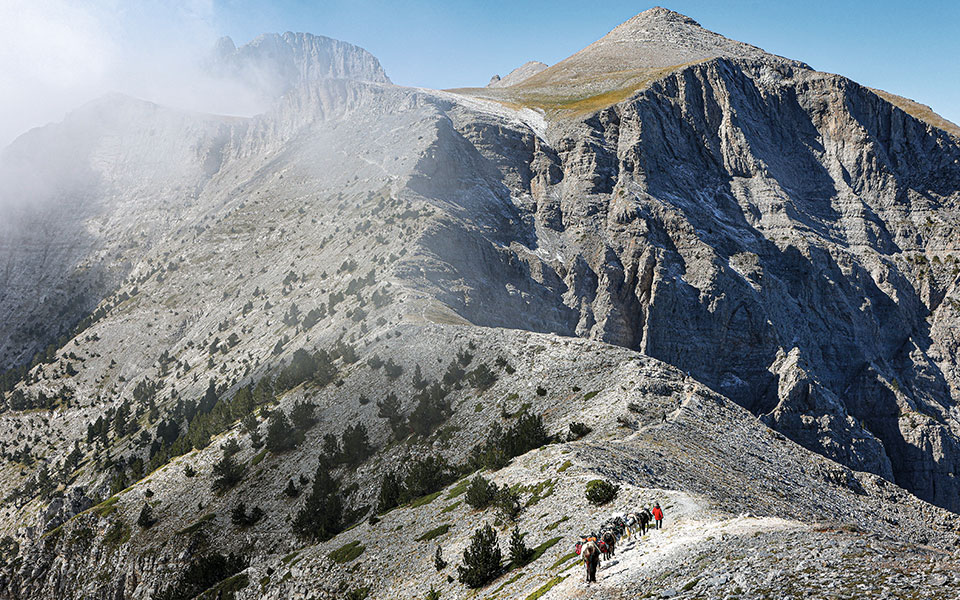It’s a sunny autumn day on Mt Olympus. The time is 09:00, and Thodoris Dosis’ mules are being loaded for the long ascent from Gortsia to the Plateau of the Muses. They will need to cover a distance of 12km and climb 1,800m through dense forest and steep alpine landscape to reach the Christos Kakkalos and Giosos Apostolidis refuges on the plateau. Unlike what they do during the summer season, the mules today are not carrying load of supplies for the alpine huts; they’re hauling equipment for a scientific mission, including an ice corer, a generator, variable sensors, air-tight sample containers, sterile test tubes, computers and camping equipment. “What more will you ask me to carry?” Dosis asks his old friend Dr Michael Styllas.
The instigator of the scientific mission that is just about to begin, Styllas is overseeing the packing and loading. Credited with changing everything on Mt Olympus since taking over management in 2003, with his brother Alexandros, of the Christos Kakkalos refuge where he lives, this geologist-explorer is a renowned figure in the world of alpine sports and was one of the nine climbers in the first-ever all-Greek mission to Mt Everest in 2004. He has contributed to the revival of traditional climbing, established Mt Olympus as an international skiing mountaineering destination, and was also a frontrunner in promoting mountain tourism in Greece.
Despite the daily challenges of working at 2,650m above sea level, Styllas has remained a dedicated and inquisitive scientist. His interest in Olympus’ permafrost prompted him to study the evolution of the glaciers since Paleolithic times in a postdoctoral study at the Academy of Athens in 2019. For the past four years, he has been involved in the pioneering Vanishing Glaciers research project of the Swiss Federal Institute of Technology (EPFL) in Lausanne. For this project, he organized and led 14 expeditions, during which he and his team climbed 35 mountains in 15 countries to collect precious samples of bacteria and other microorganisms living in glacier-fed streams. Now he’s back on his beloved Olympus as the mastermind of the most extensive interdisciplinary expedition ever conducted on the legendary Greek mountain.
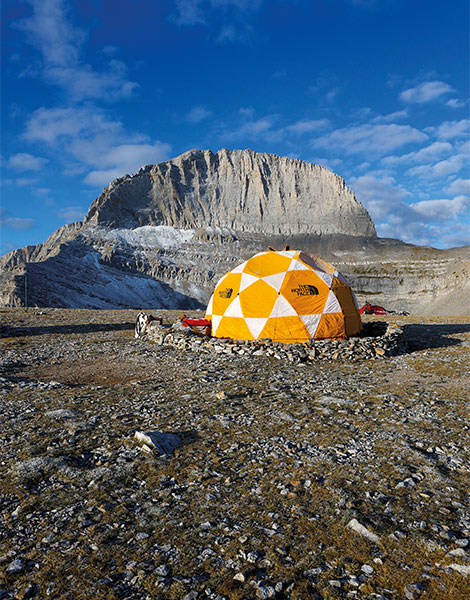
© Babis Giritziotis
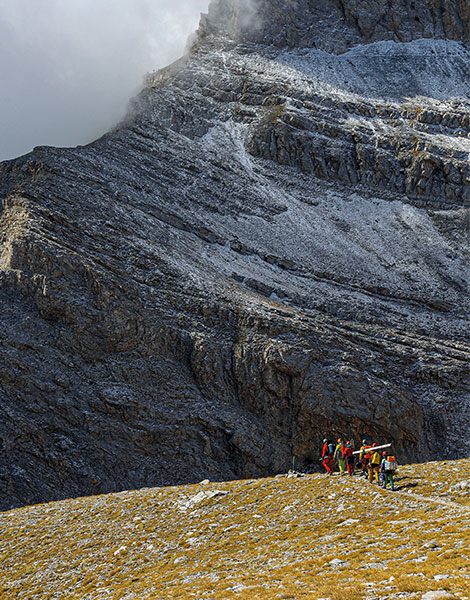
© Babis Giritziotis
A multifaceted scientific endeavor
PalΑeolus is an international research project which aims to reconstruct the paleoclimate and atmospheric circulation in southeastern Europe by studying an unexplored cave, Chionotrypa (“Snow-hole”), located below the highest summits of Olympus. The key objective is to study the cave’s permafrost to glean information about the climate, ideally data related to the last 5,000 years. The team is led by Dr. Aurel Persoiu, an expert in speleology, paleoclimatology and geomorphology at the Romanian Academy of Sciences, and includes renowned scientists from different parts of the world, including Styllas.
The mules will have to ascend seven times over the next few days to bring up more than a ton of scientific equipment and camping, climbing and speleological gear. During our climb, it drizzles every so often, but the tall black pines (Pinus nigra), thirsty from the summer drought, hold the water for themselves, keeping gear, animals and people dry until we all reach the Petrostrouga refuge at 1,940m – the halfway point to the Plateau of the Muses. We all welcome the hot tea, food and warmth on offer here before we face sleeping the next few nights in tents in -10°C weather.
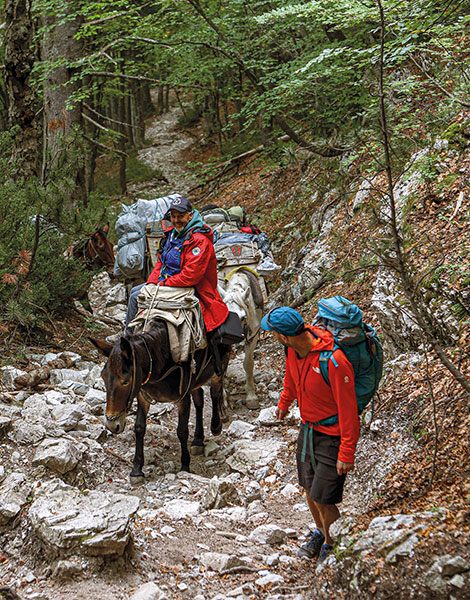
© Babis Giritziotis
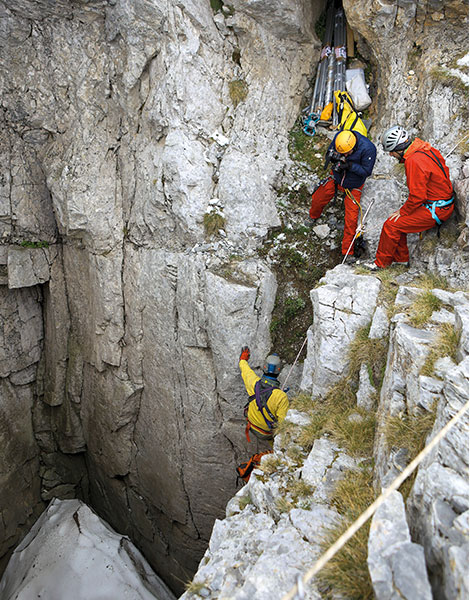
© Babis Giritziotis
On this first night we get the first snow of the season. By the time we reach the plateau early on the following afternoon, there’s just a light dusting left – a reminder that winter is coming. The next day, we set off on the slow ascent with a group of young climbers. It’s impressive to see how many people are nowadays allured by mountain pursuits. We finally reach Kakkalos Refuge and find that the mules are there, too. The scientific team is now complete. The scientists working intensively in the field do not look much like university lecturers. They kick off the expedition by unloading the animals, setting up their tents and getting their HQ, a sizeable igloo-style tent dubbed “the Dome,” in order. The Dome protects all the equipment and it’s where the team gathers every evening to evaluate that day’s work and plan for the next one.
They get to work immediately. “Our plan is to drill the ice and retrieve an ice core that will be as long as possible. That means ‘as old as possible.’” It may sound like a simple process, but it’s arduous work. The first step is to rig the cave for climbing and haul the drill, ice corer and generator up to that remote location on our shoulders. The team dons caving suits and safety gear – helmets and harnesses. Some carry drill pipes, while four team members take on the most laborious task: hauling the bulky 60kg generator through the narrow, steep pass. One misstep can cost precious equipment and injury.
Experienced speleologist Yorgos Sotiriadis has rigged the cave, drilled and placed all the anchors on the vertical wall so the team can make the descent. The equipment is carried to the base of the trail – and that’s when things get tricky. Ahead of us, we can see a vertical wall. The generator cannot possibly be taken any higher. It will need to be placed at a lower elevation and connected with a series of extension cords. For now, the generator is quiet and so is the drill, and the team has to leave the cave.
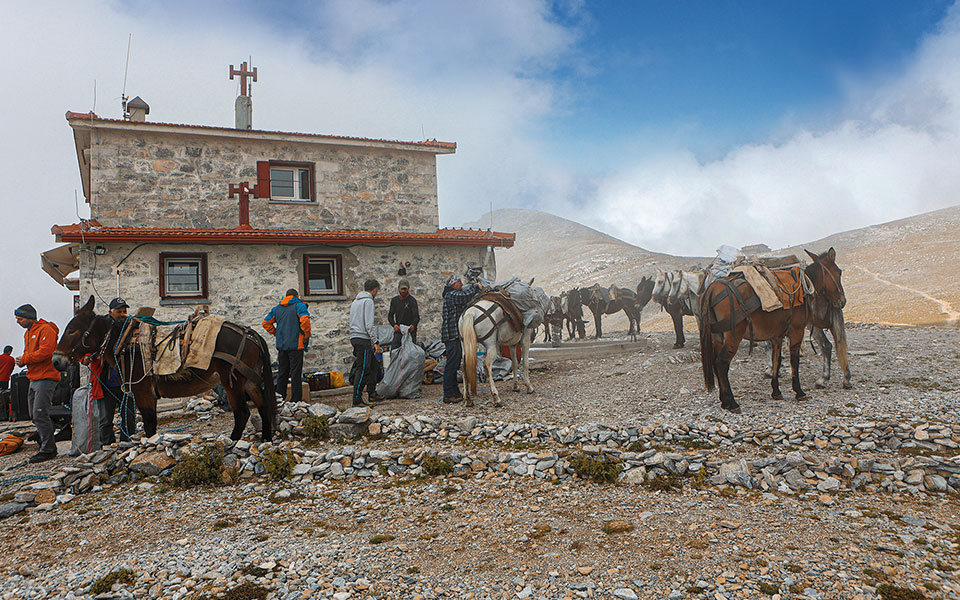
© Babis Giritziotis
Between disappointment and euphoria
That night, back at HQ, the team examines alternative courses of action. With Sotiriadis, another two speleologists – geomorphology researcher Dr Christos Pennos, from the University of Bergen in Norway, and Dr Stavros Zachariadis, who holds a PhD in archaeology from the Aristotle University of Thessaloniki – are focusing on geomorphology. They are working with a Norwegian counterpart, Professor Rannveig Ovrerik Skoglund, also from the University of Bergen, who is an expert on speleogenesis (or cave formation) in glacial settings. “The cave is dynamic; it’s changing. The cave ice has retreated significantly since we first visited in 2013 due to climate change. This means that as the ice melts from the outer part of the deposit [i.e., close to the walls], you get gaps between the ice and the wall, which will enable us to get down even further,” explains Pennos. Their task is to place sensors that will record data on the temperature and humidity over time, as well as a camera that will record changes in the height of the ice. The camera, developed by the Hellenic Institute of Speleology, was donated to this expedition.
The technical obstacles are quickly dispatched over the next two days. The generator is fired up and the drill comes to life. It’s a big moment. The team has its first samples. The first ones of soft snow fail to satisfy, but those at 4m down are more rewarding, as they show the union between the snow and the ice. You can see all kinds of sediment in the transparent sample – possibly organic – that promises to be valuable to the research. The signs are hopeful. But a technical glitch pitches the drill back into silence just as Sotiriadis, looking disappointed, returns from a foray into the cave. All the evidence points to several deep caverns in the area, but no way to access them. The mapping shows a depth of 32m, of which 26m is covered in ice.
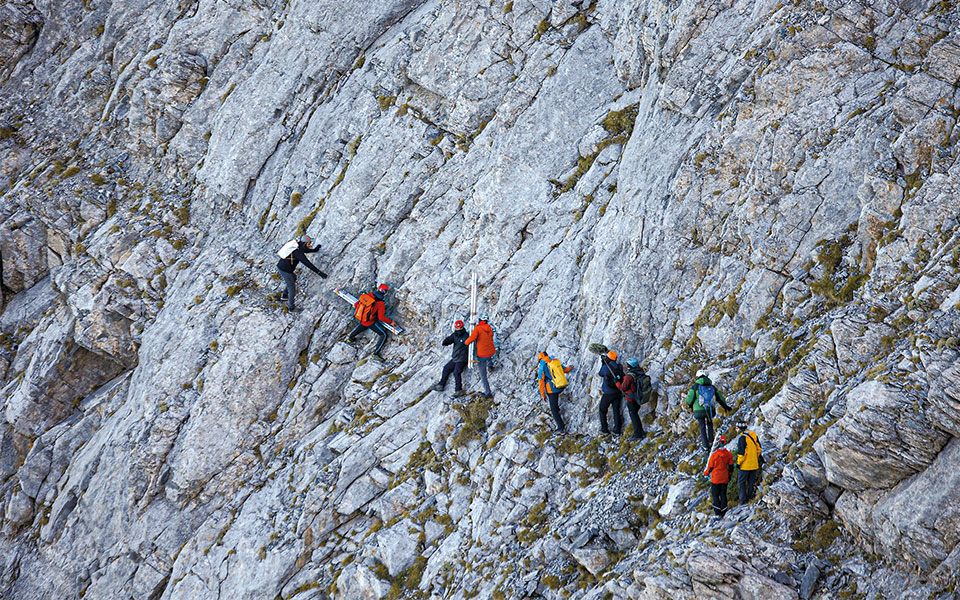
© Babis Giritziotis
From the field to the lab
The ice sample is temporarily stored in the refuge’s freezer. A 10cm piece will be cut from it, split up, placed in sterilized sample containers and sent to laboratories in Greece and abroad. “Our aim here on Olympus is twofold,” notes Persoiu. “We want to analyze the water from the ice, which will give us evidence about climate change. We are also looking for information about the transfer of dust from the Sahara Desert, as climbers have reported the mountain being covered in a red veil at the end of the winter. Identification and chronology will allow us to ascertain any changes in the frequency and intensity of the southerly (Sirocco) winds that bring the dust from the desert.”
It all starts with assigning an age to the ice. This means analyzing the organic matter trapped inside it, like pieces of wood, leaves or bat guano. Then the water from the ice is analyzed in terms of oxygen and hydrogen isotopes to decipher the changes in winter temperatures over the years and define the sources of humidity. Did the water vapor come from some cold, wet area in the northern Atlantic or from the warmer rainfall of the Aegean? Was the wind blowing at that particular time westerly or southerly? Similar studies using isotopes of strontium are being carried out to identify the provenance of Sahara dust.
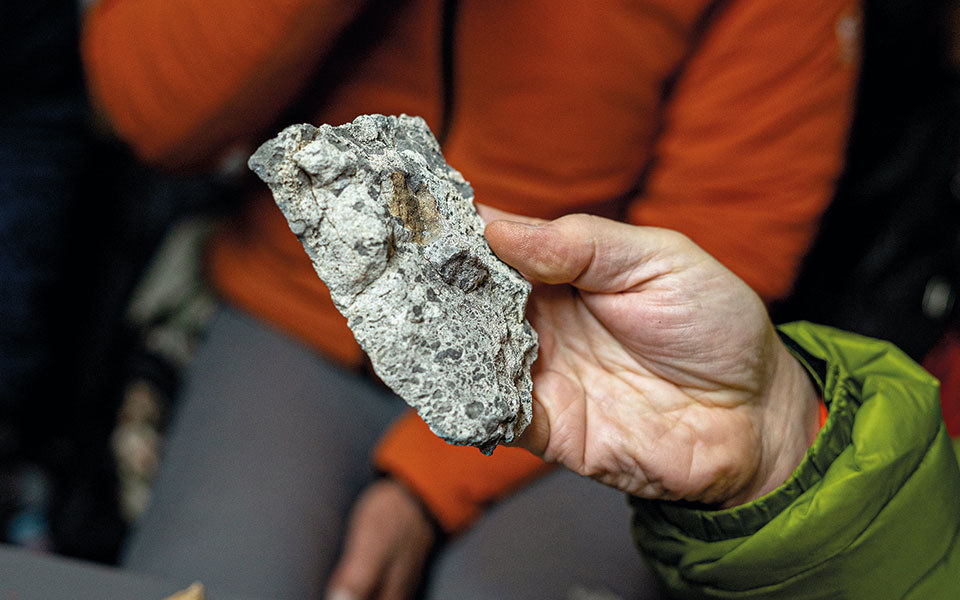
© Marika Tsouderou
In parallel with Persoiu’s research, University of Athens mineralogy professor Athanasios Godelitsas is studying the solid matter discovered in the ice. “Ice is a unique archive of information you cannot easily find in non-glaciated parts of Earth. Solid particles trapped into the cave ice are the main focus of the research. What minerals are there? How old they are and where do they come from?” The liquid from melting the ice is filtered – much like coffee, but in a sterile environment – so solid particles can be collected. Depending on their size – from millimeters to nanometers – they are analyzed and identified through either an optical or electronic microscope. “The smaller they are, the harder they are to collect but the more interesting they are scientifically. Microscopic particles are usually transported in the air from distant places and yield interesting information, including their chemical composition. If, for example, one of these particles contains silica, aluminum and magnesium, it might be volcanic glass. A particle may have been transported around 3,600 years ago, from the Santorini volcanic eruption, and trapped here,” he says.
The findings in the ice will be confirmed by a parallel study being conducted by Styllas and Godelitsas on samples collected from alpine soils at the Plateau of the Muses and bedrock samples from the Mt Olympus alpine zone, which are being analyzed for traces of zircon, scandium, thorium, chromium and nickel. “The discovery of these elements will reveal the provenance of these geological materials and will create linkages with geomorphological and climatic changes over time,” Godelitsas says. “Do these materials stem from other human activities, such as the copper workshops of Pieria, for example? Or could they even confirm myths like asteroid and meteor impacts in the area?”
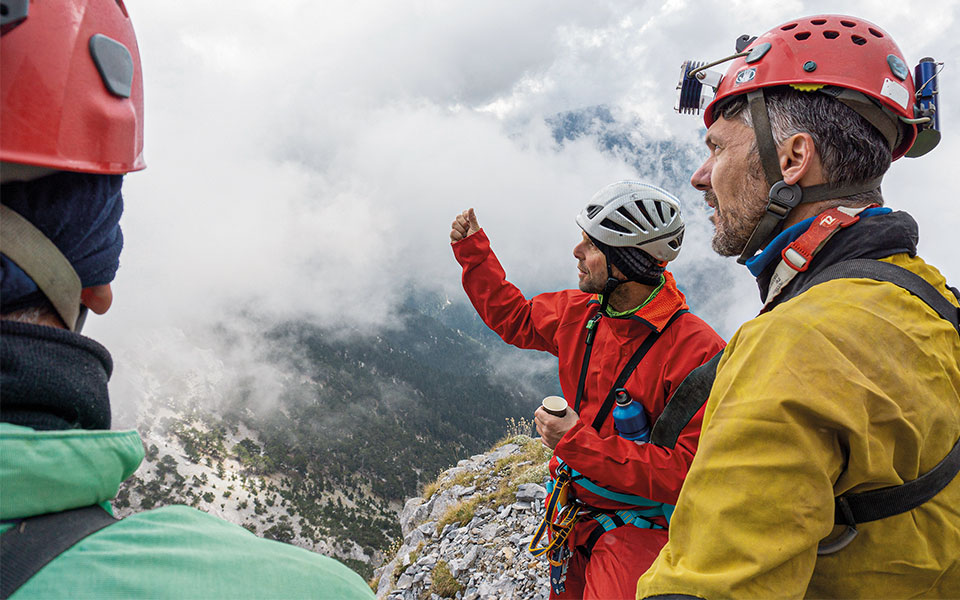
© Marika Tsouderou
The need for a research center
There is great interest in the initial results of the research, expected by the end of the year. The team hopes to address the most important scientific question: to what extent is climate change a natural phenomenon or one caused by humans? Given the dearth of publications on the subject in Greece – with studies mostly limited to the Peloponnese and certain mountain regions – the survey on Mt Olympus is expected to garner vital new data on climate history. “People often ask what the future holds. Have we messed up a lot with the climate? We certainly have. We’ve added methane and carbon dioxide to the atmosphere, which is measurable. But nature has its way of reaching equilibrium, so you can’t really know how much we’ve messed with it, especially on a local scale. You can only understand the qualitative and quantitative characteristics once you’ve recorded the natural pace of climatic change,” say Styllas.
“You can say, for example, that dry winters are not abnormal. We have historical records saying that when Saint Dionysios was here in 1540 CE, the Enipeas River dried up. This tells us that there were extreme weather phenomena before the Industrial Revolution. Right now, we are looking at a plethora of divergent scenarios. The aim is to record natural rhythms at the local level and to make connections to what we know from history.”
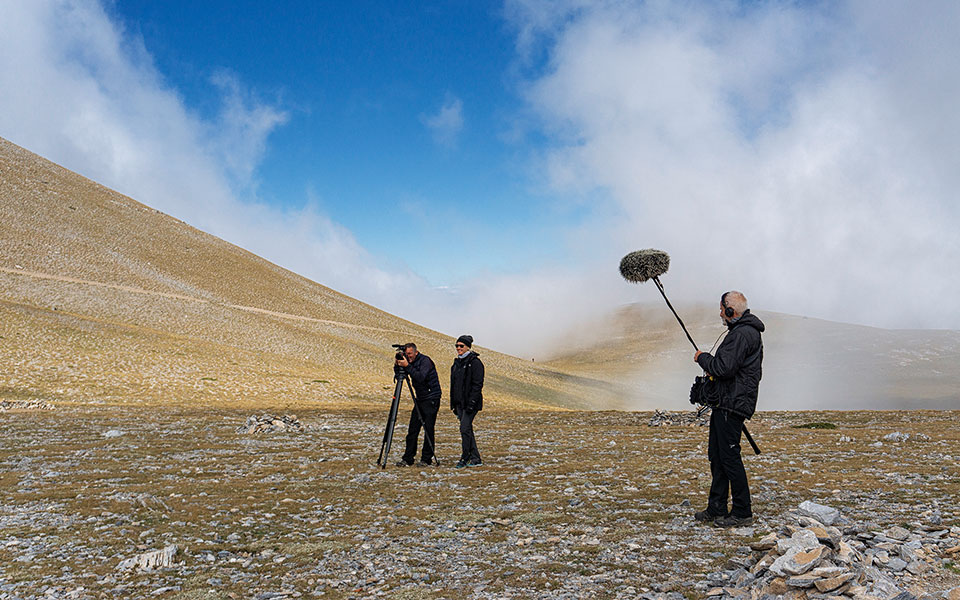
© Marika Tsouderou
The research does not end here. Styllas mentions the absence of a research center in Greece dedicated to the alpine environment – except for important work being done in Metsovo by the National Technical University of Athens – and talks of his experiences from four years of scientific missions to refuges in New Zealand, Greenland, Chile and Ecuador. “The area of Olympus has been a crossroads of civilizations. Paleolithic and Neolithic people had no concept of borders. Today, environmental change and degradation issues augment our joint history with the people of the southern Balkans and western Turkey. With this in mind, our next goal is to establish a research center for the alpine environment of southeastern Europe, one which will specialize in climate change, natural disasters and sustainable mountain tourism development,” he explains.
Walking with the scientific team on these autumnal days across the lofty slopes of Olympus, I catch splendid sights as I turn my head every so often: high peaks, fertile plains and the blue Aegean Sea, all in one frame. “Olympus is the antenna in the landscape you’re describing,” says Styllas. “It receives African dust and Balkan smog, is likely affected by acid rain, and is an indicator of water sufficiency for agriculture and tourism. It’s also of enormous significance in history and in myth. In my opinion, we don’t need more tourists; we need more scientists to ensure a sustainable future for the area.”
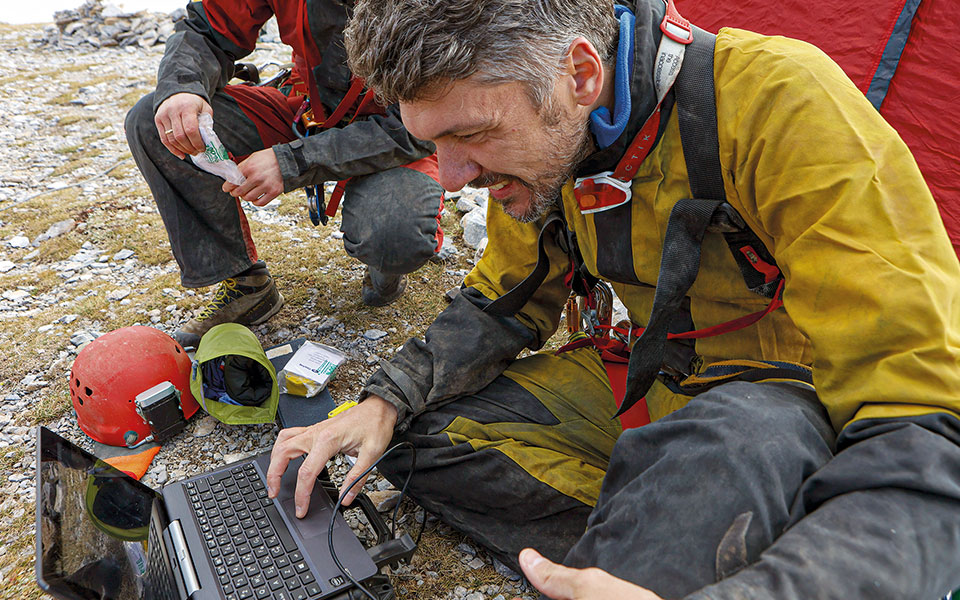
© Babis Giritziotis
Dr Christos Pennos, Speleologist-geomorphologist, University of Bergen The threat of drought looms closer
“The only glaciers in this country have been identified in small caves. I assure you that it’s frightening for us cavers to witness the speed at which the ice is melting because it makes us picture the impact this will have on many natural systems. Climate change is a fact; unfortunately, it is also really trendy. Companies are even using it in advertising, making it hard for people to understand what it means in real terms for their lives. No one is talking about the impact this change will have on the number one resource: water. In Greece, up to 60% of the water we drink comes from karstic systems, meaning caves, and caves are extremely sensitive to climatic changes. The impact will be huge, and even more so in the Mediterranean systems that will be affected. This will clearly impact our country, and climate change will develop into a climatic crisis.”
Anne Viry-Babel, French filmmaker whose documentary “Τhe Secrets of Mount Olympus” follows the scientific study.
“I began filming and exploring Olympus in 2013 and have climbed the mountain dozens of times since then. I’m also studying the myths and legends surrounding it. The aim of my new documentary, produced in cooperation with ARTE, is to connect elements of ancient mythology with observations and scientific data. These include, for example, the intense lightning activity; ancient winds and how they were associated with specific gods and monsters; the stars, the planets and the legend of the birth of the galaxy; and Olympus’ mystical and natural beauty, which makes it unique and, thanks to elements such as theThrone of Zeus, inspirational.”
Dr Αurel Persoiu, Head of the PalΑeolus research program What is PalΑeolus?
“The project aims to reconstruct the climate in southeastern Europe over the past 5,000 years. We plan on drilling for samples in caves and in cave deposits – stalagmites and stalactites – as well as in lagoons in Romania, Slovenia, Croatia and Greece. In the lagoons, we’re looking for sand blown to the coasts during powerful storms at sea, and in caves, we analyze the water from the ice. The research in Greece is focused on the caves of Falakro in Drama, in the Lefka (“White”) Mountains of Crete, on Mt Olympus, and at the watersheds of the Pineios and Nestos rivers, as well as at the Korission Lagoon in Corfu. By recreating the climate regionally, we can identify patterns that lead us to a regional model yielding evidence about atmospheric circulation, and find out to what degree the paleodata mimics the new data.”

